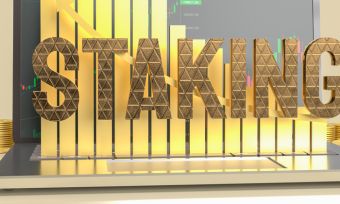The cryptocurrency experts at Easy Crypto run us through DeFi, or, decentralised finance.
The world of cryptocurrencies is expanding at such a rapid rate. And in doing so is birthing new possibilities and industries. One of those being the world of decentralised finance or, as it’s commonly referred to, DeFi.
So, what is decentralised finance?
To put things simply, DeFi is a union between traditional banking services with decentralised technologies, such as cryptocurrencies and decentralised applications (or DApps).
Technically speaking, decentralised finance refers to a merger of all the decentralised products and services. For example, crypto assets, smart contracts, protocols and applications.
In order for you to get a better understanding, we break this down a little further by comparing DeFi to traditional financial systems.

Comparing DeFi with traditional or legacy finance
Conventional financial system have central authorities at their core, for example central banks and governments, which set monetary and fiscal policies, to ensure financial stability.
Users then rely on middleman – corporate banks and other financial providers – for all day-to-day transactions, from payments and savings to loans and credit cards.
But with DeFi, this does not have to be the case.
DeFi is part of the Open Finance Movement that enables money and payments to be universally accessible, to anyone in the world, no matter where they are, free of government regulations. Imagine a global, open, alternative to every financial service you currently use: savings, loans, insurance and more.
DeFi vs. traditional financial services
DeFi honours the principle of decentralisation. This means that DeFi protocols or apps require its code to be transparent on the blockchain so that anyone is able to carry out an audit. This paves the way for a different kind of trust between participants because anyone has the opportunity to understand how a contract works, or even to find potential bugs.
Transaction activities are open for the public’s review — yes, that includes you and me. Although some people are concerned about privacy issues, rest assured, as transactions are pseudo-anonymous.
DeFi protocols and applications are not fully managed by a single entity, its developer, or its employees. Instead, rules are typically written in code or smart contracts.
Once the smart contract is deployed onto the blockchain, applications are able to run on their own without further intervention. The only time developers are involved is when upgrades are needed, or to carry out maintenance, such as bug fixes.
Benefits of DeFi
- DeFi apps are designed for a global audience. Anyone from around the world can participate in DeFi platforms. All you really need is a smartphone with internet access. DeFi also offers programmability
- The DeFi movement has the possibility of providing financial services for those who might not have access to traditional financial services
- Immutability. This means that data coordination across the blockchain is tamper-proof and this increases security and auditability
- Interoperability. Since Ethereum’s software stack is composable, DeFi protocols and applications are built to be integrative and complementary. This means that those involved in DeFi have the flexibility to build on top of other existing protocols, or to integrate other third-party applications. Think about DeFi as money Lego.
 Takeaway
Takeaway
Should you consider investing in DeFi?
Well, like any investment, DeFi, too, has its risks. In fact, because it is such a young market, the DeFi market does come with a greater degree of risk. However, many believe that DeFi has a lot to offer in how we make purchases and settlements.
Perhaps the biggest risk is that most newcomers to the DeFi space are unable to differentiate a good project from a bad one. Not all DeFi projects succeed. In fact, many do fail. And there are plenty of bad ones.
A project called YAM crashed and burned when its US$60 million market capitalisation slumped to US$0 in 35 minutes.
As with any emerging new industry, it can take time for projects to find their feet, and that can pose a heightened level of risk. Others will deliberately take advantage of the lack of regulation and target unsuspecting investors with scams and hacks.
That’s why, whenever it comes to all things crypto, it’s important to do your research and understand the risks and to consult a financial specialist if necessary.
Where to buy Crypto in NZ
The display order does not reflect any ranking or rating by Canstar. The table does not include all providers in the market.
| Provider |
Fiat Currencies |
Bitcoin |
Other Currencies |
Est. |
| Easy Crypto |
NZD, AUD |
Yes |
100+ |
2018 |
| Independent Reserve |
NZD, AUD, USA |
Yes |
24 |
2013 |
| Kiwi Coin |
NZD |
Yes |
No |
2014 |
| Swyftx |
NZD, AUD |
Yes |
228 |
2017 |
This information is not an endorsement by Canstar of cryptocurrency or any specific provider. Canstar is providing factual information supplied by providers. Cryptocurrencies are speculative, complex and involve significant risks. Canstar is not providing a recommendation for your individual circumstances or in relation to any particular product or provider.
Learn more about cryptocurrency here

Easy Crypto is New Zealand’s safe and easy Bitcoin & Cryptocurrency retailer. It’s open 24/7, guarantees every order, and most orders are completed within two minutes. Sign up today or follow Easy Crypto on Twitter, Instagram, or its YouTube channel to stay up-to-date with all the latest crypto news.

 Takeaway
Takeaway



Share this article